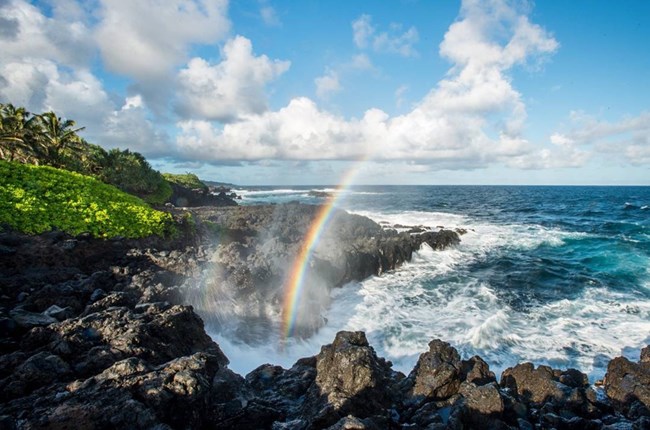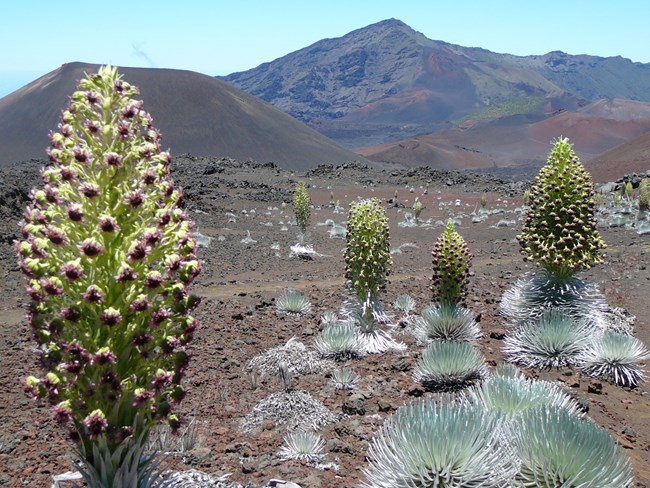Part of a series of articles titled Park Air Profiles.
Article
Park Air Profiles - Haleakalā National Park
Air Quality at Haleakalā National Park

Most visitors expect clean air and clear views in parks. On the island of Maui, Hawai'i, Haleakalā National Park (NP) is removed from many sources of air pollution. However, volcanic gases and particles from the Kilauea Volcano on the nearby (big) island of Hawai'i are transported to Maui on "kona" winds, affecting air quality and visibility in the park.
The Kilauea Volcano, located in Hawai'i Volcanoes NP on the island of Hawai'i, is approximately 100 miles from Haleakalā NP. Kilauea's nearly continuous eruption emits a volcanic plume of emissions causing air pollution downwind of the volcano. The sulfur dioxide (SO2) in eruption plumes reacts with oxygen, water, and particles in the air to form sulfuric acid droplets and solid sulfate particles known as vog (volcanic smog) and corrosive acid rain. Vog damages crops and can aggravate pre-existing respiratory ailments (Orr et al. 2013). Vog also creates a haze that obscures visibility. Adding to the haze are marine aerosols, which can make it even harder to see far and clearly. In addition, the volcano emits fine particulate matter (PM2.5), hydrogen sulfide, hydrogen chloride, hydrogen fluoride, mercury, and other harmful gases which can travel with southeasterly "kona" winds to Haleakalā NP.
Short term exposure to high levels of sulfur dioxide (SO2) and particulate matter (PM2.5) can be harmful to human health. Haleakalā NP is far enough removed from the volcano that sulfur dioxide levels do not exceed the National Ambient Air Quality Standards set by the Environmental Protection Agency to protect public health. Nevertheless, vog periodically affects Maui, including Haleakalā NP.
In addition to this natural source of air pollution, there are local human-caused air pollution sources that can degrade air quality, including power generating stations, sugar cane processing facilities, agriculture, and vehicles. Air pollutants blown into the park can harm natural and scenic resources such as soils, surface waters, plants, wildlife, and visibility. The National Park Service works to address air pollution effects at Haleakalā NP, and in parks across the U.S., through science, policy and planning, and by doing our part.
Sulfur and Nitrogen
Sulfur and nitrogen compounds deposited from the air may have harmful effects, including acidification, on soils, lakes, ponds, and streams. The ecosystem sensitivity to acidification at Haleakalā NP relative to other national parks is very high (Sullivan et al. 2011c; Sullivan et al. 2011d). Some plants are especially sensitive to acidification, search for acid-sensitive plant species found at Haleakalā NP.
The park’s steep slopes lead to rapid run-off with little time to buffer acidic ions. The park’s freshwater streams and ponds may be sensitive to sulfur compounds emitted from the Kilauea Volcano. A study on baseline water quality at the park reported pH values of less than 6.5 between 1972 and 1995 in the park’s freshwater streams (NPS 1999). Low pH (high acidity) may be the result of atmospheric deposition of sulfur from Kilauea’s volcanic emissions or from naturally-occurring sulfur in bedrock.
Excess nitrogen can also lead to nutrient enrichment, a process that changes nutrient cycling and alters plant communities. Although nitrogen deposition levels are low at the park, ecosystem sensitivity to nutrient enrichment at Haleakalā NP relative to other national parks is high (Sullivan et al. 2011a; Sullivan et al. 2011b). Nitrogen-limited, subalpine shrublands and alpine communities at the park may be vulnerable to changes caused by nitrogen deposition such as shifts in plant community composition. Invasive grasses tend to thrive in areas with high nitrogen deposition, displacing native vegetation adapted to low nitrogen conditions (Brooks 2003, Schwinning et al. 2005). Non-native plants and wildlife introduced by humans severely threaten native flora and fauna at the park.
Healthy ecosystems can naturally buffer a certain amount of pollution, but as sulfur and nitrogen accumulate, a threshold is passed where the ecosystem is harmed. “Critical load” is a term used to describe the amount of pollution above which harmful changes in sensitive ecosystems occur (Porter 2005).
Persistent Pollutants
Pollutants like mercury and pesticides are concerning because they are persistent and toxic in the environment. These contaminants can travel in the air thousands of miles away from the source of pollution, even depositing in protected places like national parks. In addition, while some of these harmful pollutants may be banned from use, historically contaminated sites continue to endure negative environmental consequences.
When deposited, airborne mercury and other toxic air contaminants are known to harm wildlife like birds and fish, and cause human health concerns. Many of these substances enter the food chain and accumulate in the tissue of organisms causing reduced reproductive success, impaired growth and development, and decreased survival.
The NPS Air Resources Division reports on park conditions and trends for mercury. Visit the webpage to learn more. Fish consumption advisories may be in effect for mercury and other contaminants (NPS 2022).
Visibility

Visitors come to Haleakalā NP to experience stark volcanic landscapes, sub-tropical rain forests, mountains, and the coast. An adventure there may include a glimpse of a rare native bird, or a hands-on experience with the Hawai'ian culture. Park vistas are sometimes obscured by haze, reducing how well and how far people can see. Visibility reducing haze is caused by tiny particles in the air, and these particles can also affect human health. Even a very small amount of particle pollution can cause a noticeable haze. Emissions from Kilauea's volcanic eruption account for most air pollution in the park, but local human-caused sources like power generating stations and vehicles can also contribute to haze and visibility impairment. Additionally, organic compounds, soot, dust, and marine aerosols reduce visibility. Significant improvements in park visibility on the haziest days have been documented since the mid 2000’s. Overall, visibility in the park is quite close to estimated natural conditions and meeting the Clean Air Act goal of no human caused impairment.
Visibility effects:
- Reduced visibility, at times, due to human-caused haze from fine particles of air pollution;
- Reduction of the average natural visual range from about 150 miles (without pollution) to about 100 miles because of pollution at the park;
- Reduction of the visual range to below 55 miles on high pollution days.
Visit the NPS air quality conditions and trends website for park-specific visibility information. Haleakalā NP has been monitoring visibility since 2007. Explore air monitoring »
Ground-Level Ozone
At ground level, ozone is harmful to human health and the environment. Ground-level ozone does not come directly from smokestacks or vehicles, but instead is formed when other pollutants, mainly nitrogen oxides and volatile organic compounds, react in the presence of sunlight.
Over the course of a growing season, ozone can damage plant tissues making it harder for plants to produce and store food. Elevated ozone levels reduce photosynthesis and growth in tropical trees, and increase tree water use (Cheesman et al. 2024, Jamal et al. 2024). Tree uptake of ozone uptake impairs carbon storage in vegetation and soil of tropical forests (Cheesman et al. 2024). Past monitoring found relatively low levels of ozone in the park that would be unlikely to cause ozone injury to plants. Still, some plants are more sensitive to ozone than others. Search ozone-sensitive plant species found at Haleakalā NP.
Explore Other Park Air Profiles
There are 47 other Park Air Profiles covering parks across the United States and its territories.
References
Brooks, M. L. 2003. Effects of increased soil nitrogen on the dominance of alien annual plants in the Mojave Desert. Journal of Applied Ecology. 40:344-353.
Cheesman AW, Brown F, Artaxo P, Farha MN, Folberth GA, Hayes FJ, Heinrich VHA, Hill TC, Mercado LM, Oliver RJ, O’Sullivan M. Uddling J, Cernusak LA, Sitch S. 2024 Reduced productivity and carbon drawdown of tropical forests from ground-level ozone exposure. Nature Geoscience. https://doi.org/10.1038/s41561-024-01530-1
Jamal R, Narayan S, Dubey R, Kannaujia R, Rai R, Behera SK, Shirke PA, Pandey V, Barik SK. 2023. Response of tropical trees to elevated ozone: a Free Air Ozone Enrichment study. Environmental Monitoring and Assessment 195:238. https://doi.org/10.1007/s10661-022-10713-5
Kohut, B. 2004. Assessing the Risk of Foliar Injury from Ozone on Vegetation in Parks in the Pacific Island Network. Available at https://irma.nps.gov/DataStore/Reference/Profile/2181540.
Kohut R.J. 2007. Ozone Risk Assessment for Vital Signs Monitoring Networks, Appalachian National Scenic Trail, and Natchez Trace National Scenic Trail. NPS/NRPC/ARD/NRTR—2007/001. National Park Service. Fort Collins, Colorado. Available at https://www.nps.gov/articles/ozone-risk-assessment.htm
[NPS] National Park Service. 2022. Fish Consumption Advisories. https://www.nps.gov/subjects/fishing/fish-consumption-advisories.htm
[NPS] National Park Service. 1999. Baseline Water Quality Data Inventory and Analysis | Haleakalā National Park. National Park Service Water Resources Division Technical Report NPS/NRWRD/NRTR-98/184. 259 pp. Available at https://irma.nps.gov/App/Reference/Profile/558535.
Porter, E., Blett, T., Potter, D.U., Huber, C. 2005. Protecting resources on federal lands: Implications of critical loads for atmospheric deposition of nitrogen and sulfur. BioScience 55(7): 603–612. https://doi.org/10.1641/0006-3568(2005)055[0603:PROFLI]2.0.CO;2
Schwinning, S., B. I. Starr, N. J. Wojcik, M. E. Miller, J. E. Ehleringer, R. L. Sanford. 2005. Effects of nitrogen deposition on an arid grassland in the Colorado plateau cold desert. Rangeland Ecology and Management. 58: 565-574.
Sullivan, T. J., McDonnell, T. C., McPherson, G. T., Mackey, S. D., Moore, D. 2011a. Evaluation of the sensitivity of inventory and monitoring national parks to nutrient enrichment effects from atmospheric nitrogen deposition: main report. Natural Resource Report NPS/NRPC/ARD/NRR—2011/313. National Park Service, Denver, Colorado. Available at https://www.nps.gov/articles/nitrogen-risk-assessment.htm
Sullivan, T. J., T. C. McDonnell, G. T. McPherson, S. D. Mackey, and D. Moore. 2011b. Evaluation of the sensitivity of inventory and monitoring national parks to nutrient enrichment effects from atmospheric nitrogen deposition: Pacific Island Network (PACN). Natural Resource Report NPS/NRPC/ARD/NRR-2011/323. National Park Service, Denver, Colorado. Available at https://irma.nps.gov/DataStore/Reference/Profile/2168727.
Sullivan, T. J., McPherson, G. T., McDonnell, T. C., Mackey, S. D., Moore, D. 2011c. Evaluation of the sensitivity of inventory and monitoring national parks to acidification effects from atmospheric sulfur and nitrogen deposition: main report. Natural Resource Report NPS/NRPC/ARD/NRR—2011/349. National Park Service, Denver, Colorado. Available at https://www.nps.gov/articles/acidification-risk-assessment.htm.
Sullivan, T. J., McPherson, G. T., McDonnell, T. C., Mackey, S. D., Moore, D. 2011d. Evaluation of the sensitivity of inventory and monitoring national parks to acidification effects from atmospheric sulfur and nitrogen deposition: Pacific Island Network (PACN). Natural Resource Report NPS/NRPC/ARD/NRR-2011/370. National Park Service, Denver, Colorado. Available at https://irma.nps.gov/DataStore/Reference/Profile/2170598.
Sullivan T.J. 2016. Air quality related values (AQRVs) in national parks: Effects from ozone; visibility reducing particles; and atmospheric deposition of acids, nutrients and toxics. Natural Resource Report. NPS/NRSS/ARD/NRR—2016/1196. National Park Service. Fort Collins, Colorado. Available at https://www.nps.gov/articles/aqrv-assessment.htm.
Last updated: September 30, 2024
